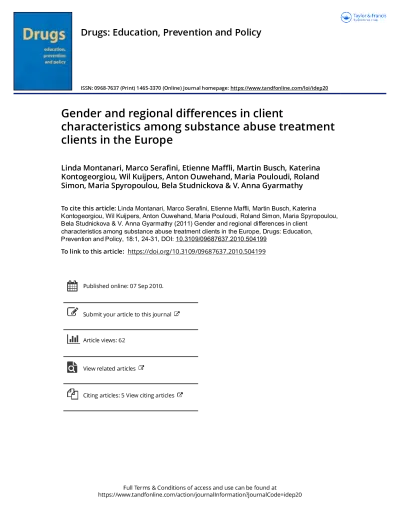Summary
Gender differences are an important aspect of substance abuse treatment (Wiechelt, 2008). Although there are more men than women in substance abuse treatment, which is mostly attributable to a higher male-to-female gender ratio among problem drug users, women drug users may have special needs relevant for treatment outcome. Some physical and mental health problems are also more common among substance abusing women than men (Greenfield et al., 2007). In addition, women advance from first drug use to drug addiction faster than men, but their addiction severity parallels that of men when they enter treatment (Hernandez-Avila, Rounsaville, & Kranzler, 2004). While women are less likely than men to enter treatment for substance abuse, after treatment entry gender is no longer associated with treatment, retention or outcome (Greenfield et al., 2007). Finally, women's response not only to drugs but also to substitution treatment is different during different phases in their menstrual cycle (Justice & de Wit, 1999; Sofuoglu, Dudish-Poulsen, Nelson, Pentel, & Hatsukami, 1999).
To provide policy support for an evidence-based public health response, European drug policy has acknowledged the importance of gender in the treatment of substance abuse. Objective 9 of the EU Drugs Action Plan 2005–2008 drew attention to developing prevention programmes that take into account gender differences (European Commission, 2005). Furthermore, the EU Drugs Action Plan 2009–2012 addresses the issue of gender in substance abuse treatment. Objective 8 of section II underlines the relevance of gender in drug demand reduction, indicating the need for the European member states to ‘enhance the quality and effectiveness of drug demand reduction activities, taking account of the specific needs of drug users according to gender’ (European Commission, 2008). The recommended actions through which this objective should be realized include the development and implementation of gender-specific good-practice guidelines for prevention, treatment, harm reduction and rehabilitation services.
Little is known about the extent of the gender gap among the treated population of drug users across Europe, which is important to assess in order to provide a basis for gender-specific treatment according to the EU Drugs Action Plans. The aim of this analysis was to describe the patterns of gender distribution, overall and by primary problem drug, among clients of outpatient treatment centres in the EU and Switzerland.
Download as PDF
PDF files are made available as a convenience. In cases where the EMCDDA is not the originator of the document, please be aware that any PDFs available on this page may not be authoritative or there may be more recent versions available. While we make every effort to ensure that these files are definitive, before using or citing them, we recommend that you consult the publisher's website or contact the author(s) to check for more recent versions.
Abstract
Aims: To assesses the extent of the gender gap among the treated population of drug users across Europe.
Methods: This analysis reports data on 363,170 clients from 4647 treatment units in 23 countries (22 European Union member states and Switzerland).
Findings: Overall, males outnumber females by four, but the gender ratio varies not only by geographical region/country, but also by drug. In the majority of countries, the most common primary problem drug is opioids, and the overall gender ratio mirrors the gender ratio of opioid users. In some countries, a considerable proportion of treated drug users have cannabis and stimulants (cocaine/amphetamines/methamphetamines) as primary problem drugs. Stimulants other than cocaine and other drugs have lower, while cannabis has a higher than overall male-to-female gender ratio.
Conclusions: The very high male-to-female gender ratios may reveal differential access to treatment. Our findings highlight the need to assess access to treatment for women problem drug users and to make women-focussed programmes more available to increase the proportion of women in drug treatment programmes across Europe.









